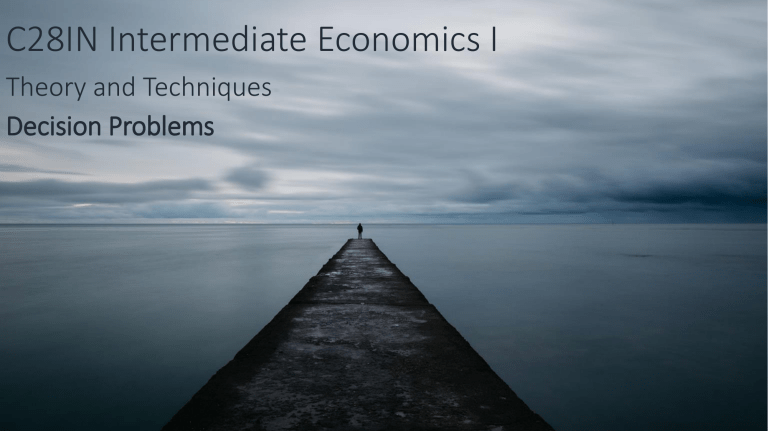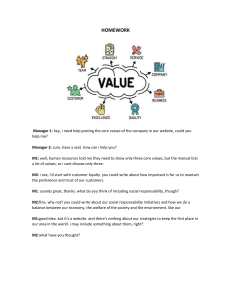
C28IN Intermediate Economics I
Theory and Techniques
Decision Problems
Decision problem
We all face situations in which we have to chose one of several alternatives.
A decision problem consists of
1. Actions: All alternatives from which the decision maker (DM) can choose
2. Outcomes: All the possible consequences that can result from any of the actions
3. Preferences: They describe how the DM ranks the set of possible outcomes
The preference relation ≽ describes the DM’s preferences. The notation 𝑥 ≽ 𝑦 means “𝑥 is at least as good as 𝑦”.
Example
Say that you have to choose between Apple and Banana for breakfast.
The set of actions is 𝐴 = {𝑎, 𝑏}, where 𝑎 denotes the choice of Apple and 𝑏 the choice of Banana.
The set of outcomes is 𝑋 = {𝑥, 𝑦} where 𝑥 indicates eat apple while 𝑦 eat banana.
If you prefer eating apple to eating banana, we can write 𝑥 ≽ 𝑦. If you prefer eating banana to eating apple, we can write 𝑦 ≽ 𝑥 .
If you strictly prefer eating apple to eating banana, you can write 𝑥 ≻ 𝑦. If you strictly prefer eating banana to eating apple, you can
write 𝑦 ≻ 𝑥.
If you are indifferent between eating apple and eating banana, we can write 𝑥 ∼ 𝑦, which is (logically) equivalent to say that both 𝑥 ≽
𝑦 and 𝑦 ≽ 𝑥 are true.
Decision problem
In some circumstances, actions do NOT coincide with outcomes.
In some cases, the action set is not finite.
Axioms
We will make two important assumptions about the DM’s ability to think through a decision problem.
Completeness Axiom: The preference relation ≽ is complete: any two outcomes 𝑥, 𝑦 ∈ 𝑋 can be ranked by the preference
relation, so that either 𝑥 ≽ 𝑦 or 𝑦 ≽ 𝑥.
We require the DM to be able to rank any two outcomes from the set of outcomes.
Transitivity Axiom: The preference relation ≽ is transitive: for any three outcomes 𝑥, 𝑦, 𝑧 ∈ 𝑋, if 𝑥 ≽ 𝑦 and 𝑦 ≽ 𝑧, then 𝑥 ≽ 𝑧.
We require the DM makes consistent choices.
Rational Preference Relation
When a preference relation is complete and transitive, we say that it is a rational preference relation.
Individual rationality Vs Group rationality. Imagine three DMs 1,2, and 3. They have to choose over three alternatives 𝑎, 𝑏, and 𝑐.
1’s preferences are 𝑎 ≻1 𝑐 ≻1 𝑏
2’s preferences are 𝑐 ≻2 𝑏 ≻2 𝑎
3’s preferences are 𝑏 ≻3 𝑎 ≻3 𝑐
Condorcet Paradox
Say they choose by using a majority voting. What will be the resulting group’ preferences ≻𝐺 ?
Between 𝑎 and 𝑐, we get 𝑎 ≻𝐺 𝑐
Between 𝑎 and 𝑏, we get 𝑏 ≻𝐺 𝑎
Between 𝑏 and 𝑐, we get 𝑐 ≻𝐺 𝑏
The three rational DMs won’t be able to reach an agreement using the group preferences from majority voting!
Payoff functions
When DMs are rational, we can replace the preference relation with a mathematical relation.
A payoff function 𝑢: 𝑋 → R represents the preference relation ≽ if for any pair 𝑥, 𝑦 ∈ 𝑋,
𝑢 𝑥 ≥ 𝑢(𝑦) if and only if 𝑥 ≽ 𝑦
We say that the preference relation ≽ is represented by the payoff function 𝑢: 𝑋 → R that assigns to each outcome in 𝑋 a real number,
if and only if the function assigns a higher value to higher-ranked outcomes.
Observe that the payoff is an ordinal construct: it is used to order alternatives and its values by themselves have no
meaning!
Decision problem
Is it always true that DMs will have a payoff function representing their preferences?
Proposition: If the set of outcomes 𝑋 is finite then any rational preference relation over 𝑋 can be represented by a payoff
function.
See, e.g., Kreps [1990a, pp. 18–37, and 1988] for a more in-depth treatment of this topic.)
The Rational Choice Paradigm
Homo Economicus is “rational” in that he chooses actions that maximize his well-being as described by his payoff function over the
resulting outcomes.
We are imposing some implicit assumptions:
Rational Choice Assumptions: The DM fully understands the decision problem by knowing:
1. All the possible actions, 𝐴
2. All the possible outcomes, 𝑋
3. How each action affects which outcome
4. His rational preferences (payoffs) over outcomes











